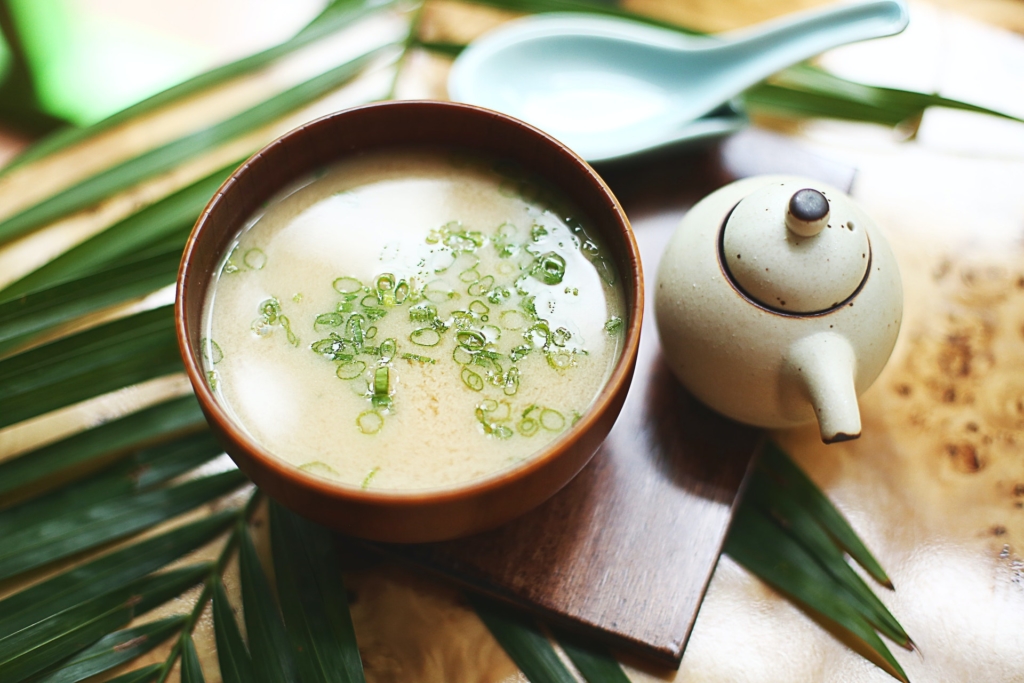Prized for its rich, savory flavor, miso is an essential component in Japanese cuisine. This umami-rich condiment is made by fermenting soybeans with salt and koji, a type of mold used to make sake and soy sauce. Koji is such an integral part in Japanese cuisine that it was named the national fungus of Japan in 2006. The koji is introduced to the soybeans by inoculating grains of barley, rice, or wheat with the fungus. These koji-rich grains are then mixed with the soybeans and salt and left to ferment for a few weeks or up to a few years. During the fermentation process, the enzymes in koji work in concert with other microorganisms to break down the soybeans and grains into simple sugars, fatty acids, and amino acids. The resulting product is a highly concentrated paste packed with salty, earthy, and funky flavors that can be used to flavor a variety of dishes.
There are thousands of different types of miso. Small variations in ingredients and manufacturing processes can alter the taste, texture, color, and aroma of the miso. For instance, the temperature the miso is maintained at, the length of fermentation time, the salt content, the variety of koji used, and the container in which the miso is fermented all influence the finished product. While there are many varieties of miso, there are three that are most common in the United States: white miso, red miso, and yellow miso.

White miso (shiro miso) is made from soybeans and a high proportion of rice. White miso is fermented for only a few weeks with a low amount of salt, giving it a mild, sweet flavor, and light color. White miso is best used for light dishes where the subtle flavor of the miso can shine.
Yellow miso (shinshu Miso) is made from soybeans and a high percentage of barley. Yellow miso is mild like white miso, but saltier and earthier in taste. Yellow miso is well balanced making it ideal for a variety of dishes such as soups, glazes, and salad dressings.
Red miso (aka miso) is fermented for a much longer period of time than white miso, giving the finished paste a dark brown color and rich umami flavor. Red miso can be made with a mix of barley, soybeans, and other grains. Because red miso is quite pungent and assertive, it is best used in hearty dishes.

In Japan, miso is considered a fundamental part of Japanese cuisine and culture. From well-known miso soup to udon, ramen, nabe, sauces, dips, and marinades, miso is used in countless Japanese dishes. While evidence shows that miso has been consumed in Japan since at least the 7th century, it is unclear just how and where miso originated. An early predecessor of miso originated in China in the 3rd century BC, but it is unclear whether miso was brought to Japan from China or if it was independently developed. Regardless of its origin, by the 13th century, miso paste and miso soup were widely consumed in Japan.
Miso is a living organism that can be negatively affected by heat. When cooking with miso, it is important to add it to hot dishes just before serving. To maintain the beneficial bacteria present in miso, the miso should not be heated above 115°F. Overcooking not only reduces the salubrious effect of miso, but it also minimizes the flavor and aroma of the miso. Miso can be used in a variety of dishes, and because miso can last up to a year in the refrigerator, it is a great condiment to have on hand when you want to add a pop of savory, umami flavor to soups, stews, dressings, or marinades. Once you’ve tasted white, yellow, and red miso, there are plenty of other types to try, from sweet chickpea miso to savory all-barley miso to ultra intense all-soybean miso. The world of miso is vast; explore and experiment with as many misos as you can to find your favorite.
Feature Image: Flickr user bike (CC BY-SA 2.0)



